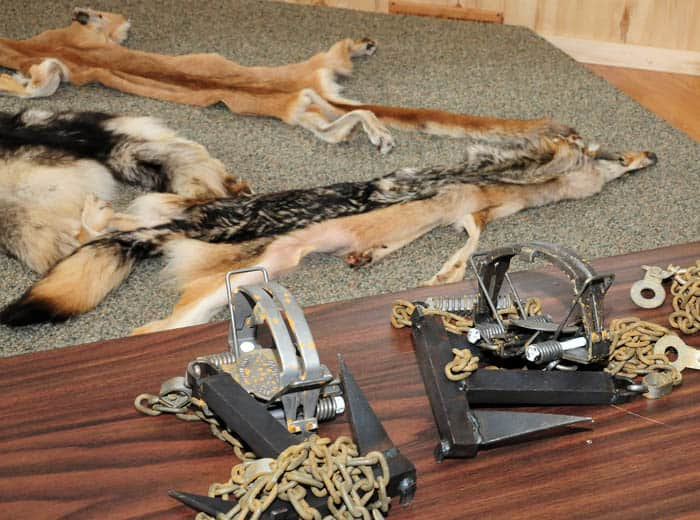Second Wisconsin Wolf Hunt Achieves Quota
Patrick Durkin 02.12.14

Wisconsin’s second wolf hunt provided new insights into hunting and trapping the state’s most controversial wildlife species, but 2013’s results differed so widely by zone and from the first season in 2012 that it’s tough to predict how future hunts will unfold.
Two certainties stand out, however: the Wisconsin Department of Natural Resources (DNR) can effectively close the season to prevent excessive overkills, and hunters and trappers comply quickly with the closures.
Further, the 2013 wolf season ended December 23, the same day the 2012 season ended; and Zone 3 was the final area to close both years.

Beyond that, few things were similar.
For instance, the 2013 season ended with a statewide kill of 257, six more than the 251-wolf quota the DNR set with input from University of Wisconsin biologists. The 2012 hunt ended with a kill of 117, one more than the quota.
Of the six-wolf excess, four came from Zone 3, where the quota was 71 but the kill was 75. Zone 3 was the only area still open December 2 when hunters could start using hounds to trail wolves. The other five zones closed between October 23 and November 7.
Zone 1—immediately north of Zone 3 in northwestern Wisconsin—had the state’s highest quota, 76, and exceeded it by one. Zones 2 and 6 were also one wolf over their quotas, with kills of 29 and 31, respectively. Zone 5 fell one wolf short of its quota (34), and Zone 4’s kill matched its quota (12).
Why did hunters and trappers need only nine, 17, 17, 22, and 24 days to fill the quotas in five zones, but 70 days to reach Zone 3’s quota? Tom Hauge, the DNR’s director of wildlife management, cited two factors: Zone 3’s high quota (71) and less public land.
“It will be interesting to see the ratio of public- to private-land results when we plot Zone 3’s harvest,” Hauge said. “With much of that zone in private hands, hunters and trappers needed to do more advance work to get access.”
The 2013 season’s fast start blazed past 2012’s pace. During Wisconsin’s first wolf season, despite a smaller quota—116 in contrast with 251—four of the six zones remained open into December, and the other two closed November 16.

Consider:
- In 2012, 67 percent of the kill (78 wolves) occurred before gun-deer season opened November 17. Trappers took 54 of those 78 wolves, or 78 percent.
- In 2013, 83 percent of the kill (213 wolves) occurred before gun-deer season opened November 23. Trappers took 172 of those wolves (81 percent). Trappers took only one wolf after deer season began. It was trapped December 1 in Washburn County.
“I think everyone learned in 2012 that trapping is the most efficient way to get a wolf early in the season,” Hauge said. Further statistics to take into account include:
- In 2012, 17.1 percent of the kill (20 wolves) occurred during deer season, of which 18 (90 percent) were shot by hunters.
- In 2013, two wolves (0.8 percent) were shot during deer season, and one (0.4 percent) was trapped.
- In 2012, 19 wolves (16.2 percent) were killed after deer season closed November 25, of which 13 (68 percent) were shot. Six (32 percent) were trapped. Hounds weren’t allowed for wolf hunting in 2012.
- In 2013, 41 wolves (15.9 percent) were killed after deer season closed December 1, and all were shot. Of those 41, 35 (85.4 percent) were killed by hunters using hounds. The other six were killed by hunters using calls.
Houndsmen accounted for 13.6 percent of the statewide wolf kill, but started slowly. After the hound-hunting season opened December 2, houndsmen killed eight wolves between then and December 14, a 0.6 daily average. From December 15 through the December 23 closure, they killed 27 wolves, averaging three daily. The big hound-hunting days were December 15 and December 20, with five wolves per day; December 21 with six wolves; and December 23 with four wolves.

“Once we got some fresh snow in mid-December, trailing conditions improved and success rates jumped,” Hauge said.
As the kill accelerated into the December 21-22 weekend, the DNR announced on December 22 that it would close the wolf season the next day at 5 p.m.
“We were somewhat surprised the pace picked up so much, which is why we started our shutdown procedures when registrations reached 64 (seven short of the quota),” Hauge said. “Hunters have 24 hours to register their wolf, so we thought we needed to shut things down sooner than we normally would.”
Even though the statewide tally exceeded the quota by six, Hauge said he felt good about the state’s first two wolf seasons.
“I remind people this is a learning experience for wildlife managers too,” he said. “But with the zones set up the way they are, the harvest got distributed the way we hoped. We protected wolves in their core areas and focused the harvest where we’ve had the most wolf-related problems.”
The DNR’s most important assessment, however, occurs after its winter wolf census. “By April, we’ll know if we achieved our projected 10 to 15 percent reduction in the wolf population,” Hauge said.

